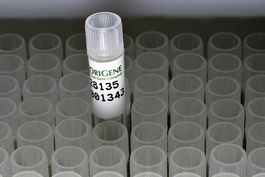AOC2 (NM_001158) Human Tagged ORF Clone
CAT#: RC217318L3
- LentiORF®
Lenti ORF clone of Human amine oxidase, copper containing 2 (retina-specific) (AOC2), transcript variant 1, Myc-DDK-tagged
"NM_001158" in other vectors (4)
Product Images

Specifications
| Product Data | |
| Type | Human Tagged ORF Clone |
| Tag | Myc-DDK |
| Symbol | AOC2 |
| Synonyms | DAO2; RAO; SSAO |
| Vector | pLenti-C-Myc-DDK-P2A-Puro |
| E. coli Selection | Chloramphenicol (34 ug/mL) |
| Mammalian Cell Selection | Puromycin |
| Sequence Data |
The ORF insert of this clone is exactly the same as(RC217318).
|
| Restriction Sites | SgfI-MluI Cloning Scheme for this gene |
| ACCN | NM_001158 |
| ORF Size | 2187 bp |
| OTI Disclaimer | The molecular sequence of this clone aligns with the gene accession number as a point of reference only. However, individual transcript sequences of the same gene can differ through naturally occurring variations (e.g. polymorphisms), each with its own valid existence. This clone is substantially in agreement with the reference, but a complete review of all prevailing variants is recommended prior to use. More info |
| OTI Annotation | This clone was engineered to express the complete ORF with an expression tag. Expression varies depending on the nature of the gene. |
| Reference Data | |
| RefSeq | NM_001158.3, NP_001149.2 |
| RefSeq Size | 2600 |
| RefSeq ORF | 2190 |
| Locus ID | 314 |
| Protein Families | Transmembrane |
| Protein Pathways | beta-Alanine metabolism, Glycine, serine and threonine metabolism, Metabolic pathways, Phenylalanine metabolism, Tyrosine metabolism |
| MW | 80.3 kDa |
| Gene Summary | Copper amine oxidases catalyze the oxidative conversion of amines to aldehydes and ammonia in the presence of copper and quinone cofactor. This gene shows high sequence similarity to copper amine oxidases from various species ranging from bacteria to mammals. The protein contains several conserved motifs including the active site of amine oxidases and the histidine residues that likely bind copper. It may be a critical modulator of signal transmission in retina, possibly by degrading the biogenic amines dopamine, histamine, and putrescine. This gene may be a candidate gene for hereditary ocular diseases. Alternate splicing results in multiple transcript variants. [provided by RefSeq, Jul 2008] |
Documents
| Product Manuals |
| FAQs |
| SDS |
Resources
Other Versions
| SKU | Description | Size | Price |
|---|---|---|---|
| SC302981 | AOC2 (untagged)-Human amine oxidase, copper containing 2 (retina-specific) (AOC2), transcript variant 1 |
USD 1,470.00 |
|
| RC217318 | AOC2 (Myc-DDK-tagged)-Human amine oxidase, copper containing 2 (retina-specific) (AOC2), transcript variant 1 |
USD 810.00 |
|
| RG217318 | AOC2 (GFP-tagged) - Human amine oxidase, copper containing 2 (retina-specific) (AOC2), transcript variant 1 |
USD 890.00 |
|
| RC217318L4 | Lenti ORF clone of Human amine oxidase, copper containing 2 (retina-specific) (AOC2), transcript variant 1, mGFP tagged |
USD 1,010.00 |
{0} Product Review(s)
Be the first one to submit a review






























































































































































































































































 Germany
Germany
 Japan
Japan
 United Kingdom
United Kingdom
 China
China

